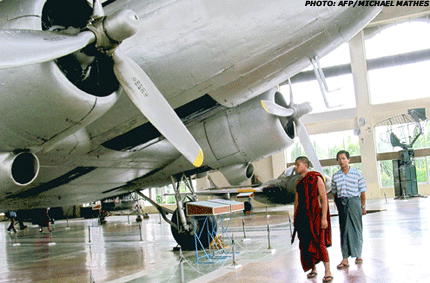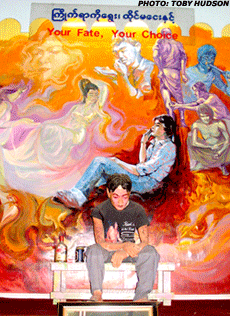Where guards shadow visitors and tout for tips
Washing hangs out to dry on the tailplanes of aircraft on display at the Defense Services Museum in Rangoon—an eye-opening new use for mothballed veterans of Burma’s air force. The laundry belongs to museum staff who live on the premises and appear to supplement their meager incomes by appealing for handouts from the few foreign visitors who call by. One female attendant trailing a reporter of The Irrawaddy said to the visitor: “I’m a government worker and I get paid 1,700 kyat (about US $1.90) a month. Why don’t you give me some money to buy medicine?”
|
|
|
A vintage Burmese air force plane on display at the Defense Service Museum |
The Defense Services Museum on Shwedagon Pyay road is one of several in Rangoon displaying exhibits that range from the bizarre to the outrageous. The gloomy Soviet-style structure stands out from the old colonial buildings surrounding it not least because of the armed guards at the front.
Welcoming visitors from the high wall of the entrance hall are portraits of Burma’s generals, organized in a tree graph with Snr-Gen Than Shwe suitably at the top. Beyond the grand but musty entrance hall is a series of cavernous rooms housing exhibits ranging from armored cars and heavy artillery to photos of bridges and Burmese gas and oil plants.
The museum is usually devoid of people and the dim lighting can turn a visit into a creepy experience. The shadowy presence of guards doesn’t help. Nor does the menacing nature of some of the exhibits and the junta slogans that accompany them. “Without communications we cannot rule and command!” declares one of them, providing an insight into the military’s power politics.
Many must leave the museum wondering if the 3 FEC (about US $3) they paid for the experience was worth the hassle. Some probably flee the pestering attention of the questioning, suspicious staff.
|
|
|
A display at the Drug Elimination Museum |
At least at Rangoon’s National Museum, on Pyay road, there’s no risk of being harassed by officious staff, who pay no attention to visitors at all. Again, staff outnumber visitors by far, and fill their time by sleeping and eating. Yet there are at least a few exhibits of interest: the Lion throne of King Thibaw and some fairly well-preserved royal robes worn by Burma’s last kings.
But the lighting is dim, the labeling inadequate and often absent altogether, and the 5 FEC entrance fee is not well spent.
If only for its curiosity value, however, Rangoon’s Drug Elimination Museum probably will be worth the expense when it reopens after extensive renovation. Much of the work on the museum in Kamayut township involves the removal of all traces of disgraced premier Khin Nyunt, whose presence dominated the entire building when he was still in power. Large portraits of Khin Nyunt hung on the walls, and a life-size dummy resembling the former leader featured in a second-floor diorama portraying the destruction of a poppy crop.
It’s to be hoped that the museum will retain a bizarre highlight: a display that gives visitors the chance to “eradicate” some illicit drugs. At the press of a button a fan comes into life and blows gold and red cellophane paper over what looks like a plastic bin-liner. Was this what the New Light of Myanmar meant when it described the museum as “high- tech” in 2004?
But forget the disappointments, the paucity of the exhibits, the intrusive staff—even the washing on the line. A trip to Rangoon’s museums can be as insightful into Burmese culture as any other tourist haunt, offering visitors a taste of history Burma-style: selective, politically charged and often downright falsified.


